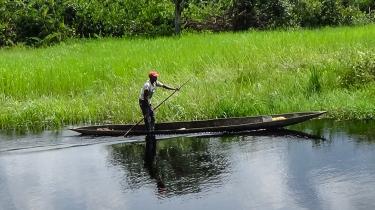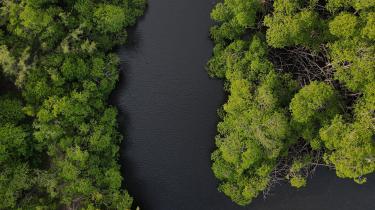In the Democratic Republic of the Congo (DRC), the reduction of emissions from deforestation and forest degradation is a major national strategic priority. Its National Forest Monitoring System (NFMS) aims to provide reliable forest resource information to help inform forest policy-making, planning and sustainable development, as well as to monitor and report on its international commitments to reduce greenhouse gas emissions. Between 2017-20, the Food and Agriculture Organization (FAO) led a programme of support to the Government of the DRC to help finalise and implement its NFMS, from satellite monitoring through to a functional web portal for monitoring and reporting. Mid-way through implementation, a Triple Line team reviewed its performance to date and provided recommendations for strengthening the programme over the second half.
The DRC is home to more than 150 million hectares of forest, representing 60 per cent of the entire forests in the Congo Basin. Managing such an expansive ecosystem is no easy task. Competing economic demands must be carefully balanced against the crucial role that the Congo Basin’s rainforest plays in regulating the local and global climate, including acting as a vast and valuable carbon sink, and its valuable biodiversity.
The DRC’s NFMS aims to provide DRC with reliable operational information on forest land-use change with the goal of helping the country meet its requirements on reducing emissions from deforestation and forest degradation (REDD+) under the United Nations Framework Convention on Climate Change (UNFCCC). DRC utilises its NFMS not only for international reporting to the UNFCCC but also as a tool that provides useful information to stakeholders outside the forestry sector, such as economic actors (working mainly in agriculture and mining) and investors, and for land use planning.
Implemented by the Ministry of Environment and Sustainable Development (MEDD) with the FAO in partnership with the World Resources Institute (WRI), the programme helped DRC manage its forest resources and meet its international commitments on sustainable forest management and greenhouse gas (GHG) emissions. Key results included a satellite land monitoring system to track forest cover trends, establishment of a National Forest Inventory to assess the use of forest resources, and a GHG Inventory to report GHG emissions related to REDD+ activities to the UNFCCC, as well as an NFMS web portal to disseminate forest-related geospatial data.
During a 10-day field mission to Kinshasa the team collected data through semi-structured interviews and focus group discussions
Triple Line carried out a mid-term review to assess the performance of the NFMS to date and its achievement of intermediate results. We assessed progress against the project work plan, the relevance and sustainability of its activities, delivery of results, efficiency of resource utilisation, participation and ownership of relevant stakeholders as well as governance and management arrangements. The review also looked at the partnerships between FAO, UNDP, MEDD and WRI and the complementarity of their methodologies. Based on this analysis, we identified priority recommendations for strengthening operation and implementation over the second half of the project.
We took an iterative and flexible approach, enabling us to deepen the assessment by testing preliminary findings from the document review through a series of interviews. We undertook a 10-day field mission to Kinshasa, the capital and the largest city of the DRC, where the team collected data through semi-structured interviews and focus group discussions with a nearly 70 interviewees from across all stakeholder groups – government, FAO, implementing partners (bilateral donors, INGOs and NGOs), technical consultants.
Based on this data collection, our subsequent analysis and further consultation, we found that the programme was on track to deliver expected results, in particular important technical tools and products including the satellite land monitoring system and National Forest Inventory, and the establishment and publication of a Forest Reference Emission Level which will enable the DRC to monitor forest cover and GHG emissions. We also found that there was a good partnership strategy between the FAO and MEDD, with effective coordination by FAO as well as technical support for government capacity.
The review identified recommendations for project adjustments in the areas of project management, harmonisation and coherence, government engagement and resourcing. Our findings helped the FAO understand the strengths and weaknesses of their programming, and laid the foundations for improvements in the second half of implementation.
Credit: title photos one and two are by Georges Thierry Handja, a Triple Line associate.
The third DRC Congo image is by Michel Reyes and downloaded from Unsplash.





